Are you struggling to connect and engage with your employees in these unprecedented times? We’ve gathered in this blog post 10 statistics that will help you identify the bottlenecks that may slow down your internal communication.
📚Check out our article on Communication Strategies and How to Create your Own.
Your internal communication is the cornerstone of your organization. No matter how big your business is, you need to have the right mix of internal communication tools and processes to connect and engage with your employees.
💡Check out the video below where IC experts share their definition of internal communication 👇
Think about it: your internal communication has a direct impact on employee productivity, collaboration across the organization, the employee experience you deliver, employee motivation, and employee engagement.
Put differently, your internal communications strategy has a tremendous impact on your business’ health overall! Check out the infographic below where we highlight some of the most common benefits of effective employee communications in the workplace 👇

How COVID-19 Has Changed Internal Communications
Who would have thought that since 2020 we would be facing one of the biggest crises — both economic and sanitary — today?
The thing is, the COVID-19 pandemic has disrupted the workplace.
All of the sudden, employees have been asked to work from home. But while some of them were used to working from home before the COVID-19 outbreak, others had to adapt to this new way of working in no time.
Team leaders had to find new ways of connecting and communicating with their teams that suddenly got geographically dispersed.

In these unprecedented times, IC practitioners have been urged to develop new internal communication strategies that would support employees and keep businesses running as smoothly as possible during the lockdown.
📚Read on: Remote Work: 20 Ways to Engage and Connect with Your Remote Employees
The #1 priority was to ensure that employees get all the information they need — including urgent COVID-19 updates and safety guidelines — in a timely manner.
However, we’ve seen an explosion of data and information being released — especially on social media — during the lockdown, which made it difficult for the employees to spot real and fake news as well as to keep up with all the information being shared by their employers.
IC professionals have been doing an amazing job at changing the way they connect and communicate with employees in no time.
In essence, the crisis has led internal communicators to:
- Implement new communication tools such as employee apps that allow them to reach employees, no matter where they are
- Target their internal audiences to make sure that every single employee gets in their news feed the information they need
- Personalize the messages they share with the employees to catch their attention
- Use push notifications to share urgent updates with the employees
- Let the employees choose what channels they want to use to communicate with the rest of the team — desktop, mobile app, emails, video calls…
- Vary the types of content they share with the employees — videos, podcasts, infographics, short posts — to make sure that their messages don’t go unseen.
- Rethink the way they measure the success of their internal communication strategy
- Encourage employees to share their feedback and thoughts even more than before
📚Read on: The Ultimate COVID-19 Crisis Management Checklist for Employers
10 Astonishing Stats on Internal Communications You Don’t Want to Miss
We’ve gathered below 10 statistics that will help you rethink your internal communication strategy in these challenging times.
1. 60% of companies don’t have a long-term strategy for their internal communications
No matter how big your company is — large or small — you need to have a long-term plan for your internal communications!

Of course, you may need to review your strategy or even redefine it later on — but you need to know what information you’re going to share internally and how you’re going to share it to your employees.
Basically, you need to know where you’re heading!
Your internal communications strategy should include key steps such as:
- Conducting an audit to understand your organizational structure and your employees’ needs when it comes to employee communications
- Setting clear and measurable objectives: do you want to keep your employees informed, to improve engagement, or help employees find meaning at work?
- Defining the messages and information you want to share to your employees
- Segmenting your internal audiences — you may not need to share the same information to your entire workforce!
- Choosing the channels you’re going to use to communicate with your employees. Are you going to keep using the company intranet, start sending out interactive newsletters or implement an employee communications app?
- Choosing the type of content you’re going to share internally. Are you going to share reports, infographics, videos or even podcasts?
- Measuring the adoption and engagement driven by your internal communications strategy.
📚Read also: Crisis Communication — How to Communicate Effectively with Your Employees
Your strategy won’t be perfect but don’t worry! Once you’ve launched your internal communications strategy, you’ll need to assess it on a regular basis to continuously improve it.
After all, internal communication is an ongoing process!
2. Only 13% of employees use their intranets on a daily basis
While it’s always a good idea to have a knowledge base and a collaboration space for your employees, most of company intranets tend to be outdated or not that easy to use. As a result, employees may use it less often until they stop using them!

Good news is that increasing the level of engagement with intranets is possible. If you want to drive adoption, you’ll need to make internal communications a bit more engaging and entertaining!
Employees care about the user experience when it comes to apps and softwares, so make sure you take it into account when you choose the channels you’re about to use for your employee communications. Think about modern intranets with possibilities for sharing videos and infographics.
Millennials and Gen Z that make the majority of the modern workforce expect internal communication tools to mimic their favorite social media channels. Look for intranets that allow you to create groups and pages by interest, follow peers the same way you would do on LinkedIn or Instagram and that make work collaboration easy and fun.
Consider also mobile-first approach for a better flexibility. For example, you may want to launch a social intranet app where employees can consume engaging content such as videos, infographics or short posts, personalize their news feed and react to the company news!
3. 74% of employees have the feeling they are missing out on company news
When information doesn’t flow, your employees get confused!
It is quite frustrating when you’re not informed about the latest company news or hear about the changes your organization is going through from your colleagues, isn’t it?
No one likes to feel they are the last ones to hear about the company news.
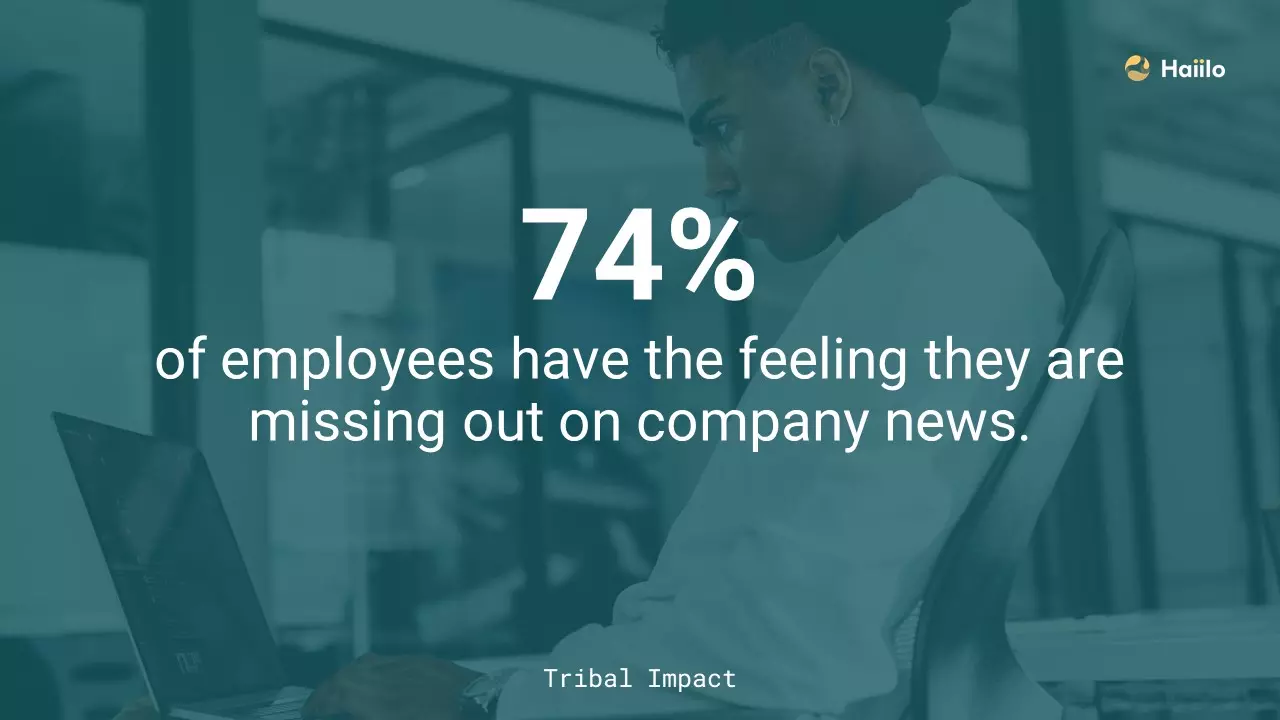
The rise of new communication technologies and the adoption of new work habits due to COVID-19 are shaking up the workplace — we need information to find us rather than having to look for it.
We don’t want to be distracted by irrelevant information. We now expect to receive instant and personalized information. We also want to start discussions and be more influential.
Companies want to be part of this change and embrace remote work. But that means they need to rethink the way they communicate with their employees.
Indeed, emails, company intranets or printed magazines are not the best channels to drive employee engagement when your employees are geographically dispersed. They may even feel excluded from the organization because of poor internal communications.
As a result, their productivity may go down and they may feel disengaged. That’s why rethinking your internal communication during these unprecedented and challenging times is critical to your business. It’s the only way you can ensure that your employees stay motivated and engaged while working remotely.
4. 72% of employees don’t have a full understanding of the company’s strategy
The lack of understanding of the company’s strategy is a direct consequence of poor employee communications.

When your employees are not aware of what’s happening in the organization, they can’t really have a comprehensive understanding of your business overall.
Think about it: how can your employees know where your business is heading if they don’t know what’s happening right now?
📚Read also: Interpersonal Communication: Definition, Importance and Must-Have Skills
Quantified Communications found that businesses as small as 100 employees spend on average 17 hours a week clarifying unclear communication which translates to an annual cost of at least $525,000!
That’s quite alarming, right?
5. Employee productivity increases by 20 to 25% in organizations where employees are connected
Did you know that employees spend on average 2.5 hours a day looking for the information they need to do their jobs?
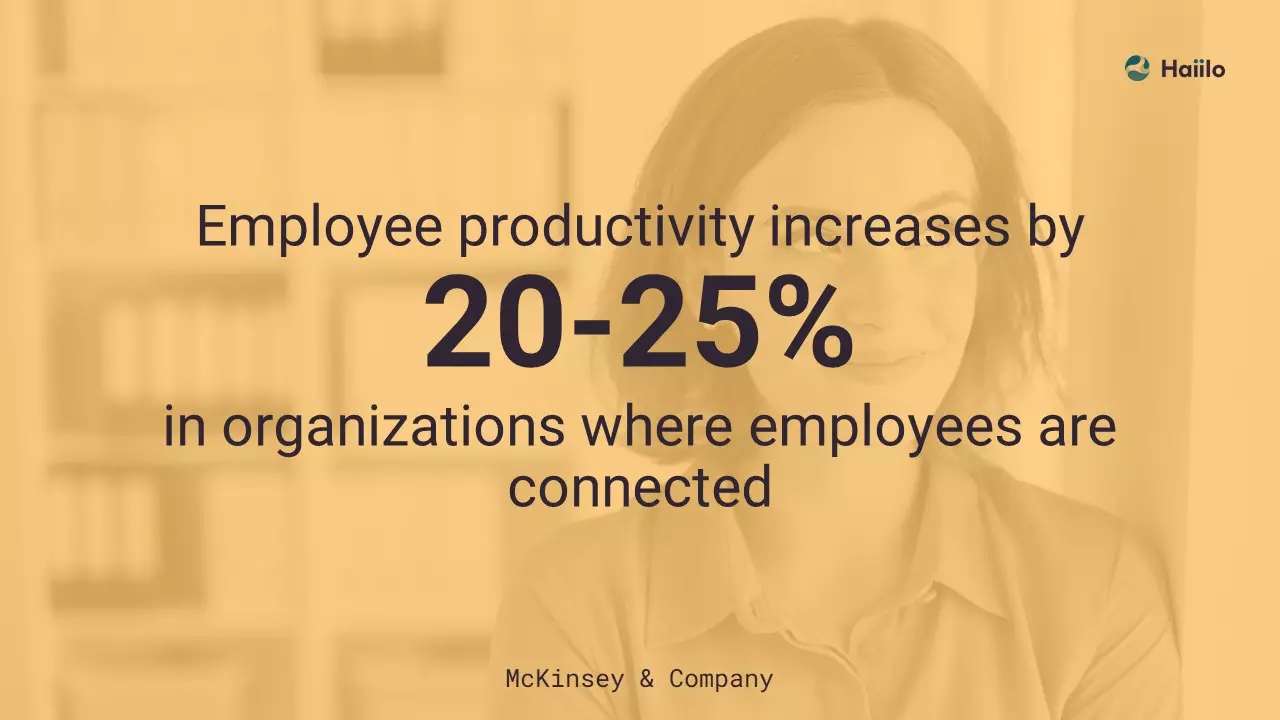
When employees struggle to find the information they need, their productivity drops.
You need to make sure that your internal communications strategy enhances information flows between departments, but also within teams.
Your employees need to know what information they need to do their job, where to find it, and to whom they ask for guidance.
Without a great internal communication in place, employees can’t coordinate their efforts in an effective way.
📚Read also: 12 Ways to Ensure Employee Productivity in the Post-Pandemic World
At the end of the day, it’s your entire business that may suffer from low employee productivity.
Productivity loss costs the U.S. a whopping $550 billion each year, so you may want to make sure that your internal communications strategy enhances collaboration across your organization!
6. Only 23% of executives say that their companies are excellent at aligning employees’ goals with corporate purposes
When it comes to employer branding, way too many businesses still focus only on the way their external audiences — mostly candidates and top talent — perceive them as employers.
However, you need to develop your employer brand internally. Your employer brand starts from the inside!

Your employees should be your first and most important audience simply because they are the ones that interact with your clients the most.
Your employees literally embody your brand.
If they are stressed, frustrated or disengaged, your clients will feel it right away! That’s why you need to get their buy-in first.
Employee engagement doesn’t mean getting your employees willing to extend their working hours but getting them excited about your brand!
Getting your employees’ enthusiasm doesn’t come easy. You’ve got to earn it.
This is where internal communications come to place.
One of the best ways to get your employees excited about your brand and to inspire them is by communicating the company’s values, mission statement and vision.
The way you communicate with your employees has a great impact on how they feel about your brand.
If you want to strengthen your employer brand, you’ve got to develop it internally.
And it all starts with your internal communications!
7. Only 40% of IC professionals believe that employees understand “well” or “very well” the contribution they’re making to their organization’s strategy
Have you ever asked yourself what your employees really care about in their job?
Even though the salaries and employee benefits you offer are important to them, what they really care about is having a meaningful job.
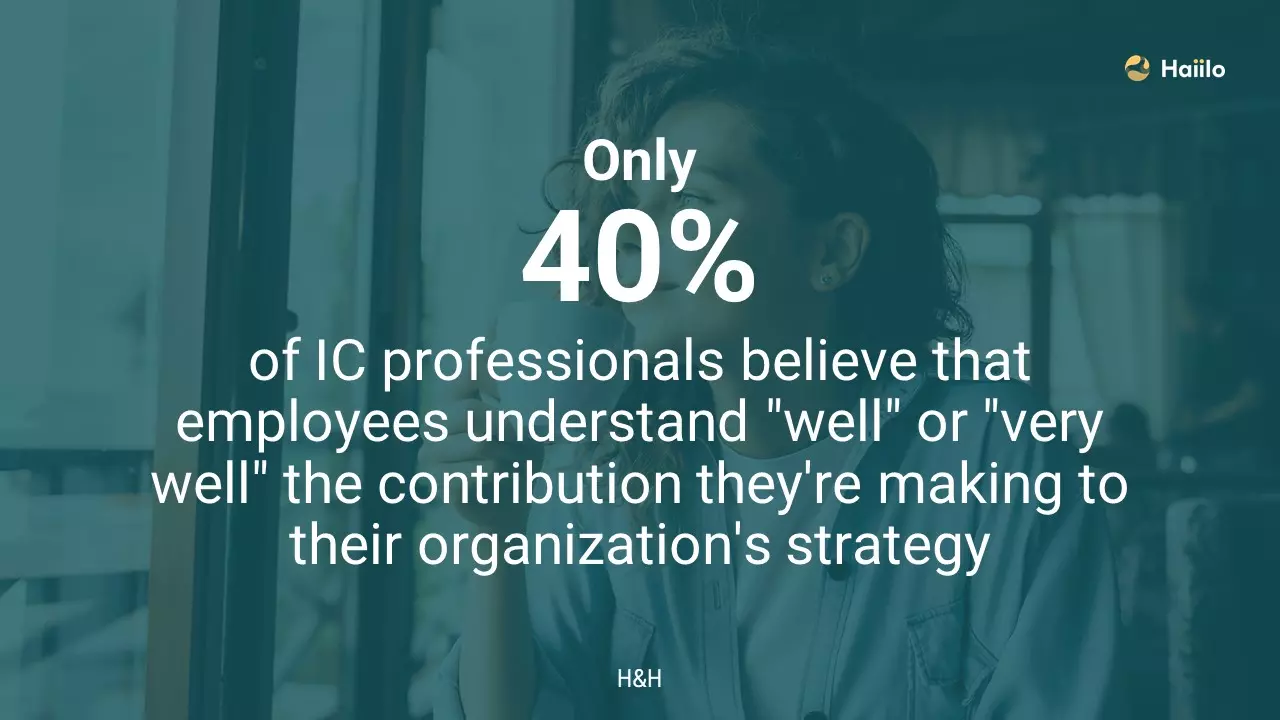
Think about it: the most respected professions include doctors, teachers, nurses, management consultants… (take a look at this research released by the World Economic Forum to learn more about the 10 most respected jobs worldwide).
What do all these professions have in common? A strong purpose.
That’s what people want in their job.
However, almost half of internal communication professionals believe that employees don’t have a clear understanding of how their work is impacting the business’ bottom line, which is a BIG issue!
Indeed, employees want to grow your business, and they want their work to be valued.
Internal communication is not only about informing employees, it’s also about helping them find meaning at work.
That’s the reason why your internal communications are so important.
📚Read on: Top 5 Communication Skills and How to Improve Them
8. 62% of the emails received by employees are not important
Your employees’ time is precious!
They check their email inboxes several times a day. But actually, most of the emails they receive are not important.
Some of them are even irrelevant.
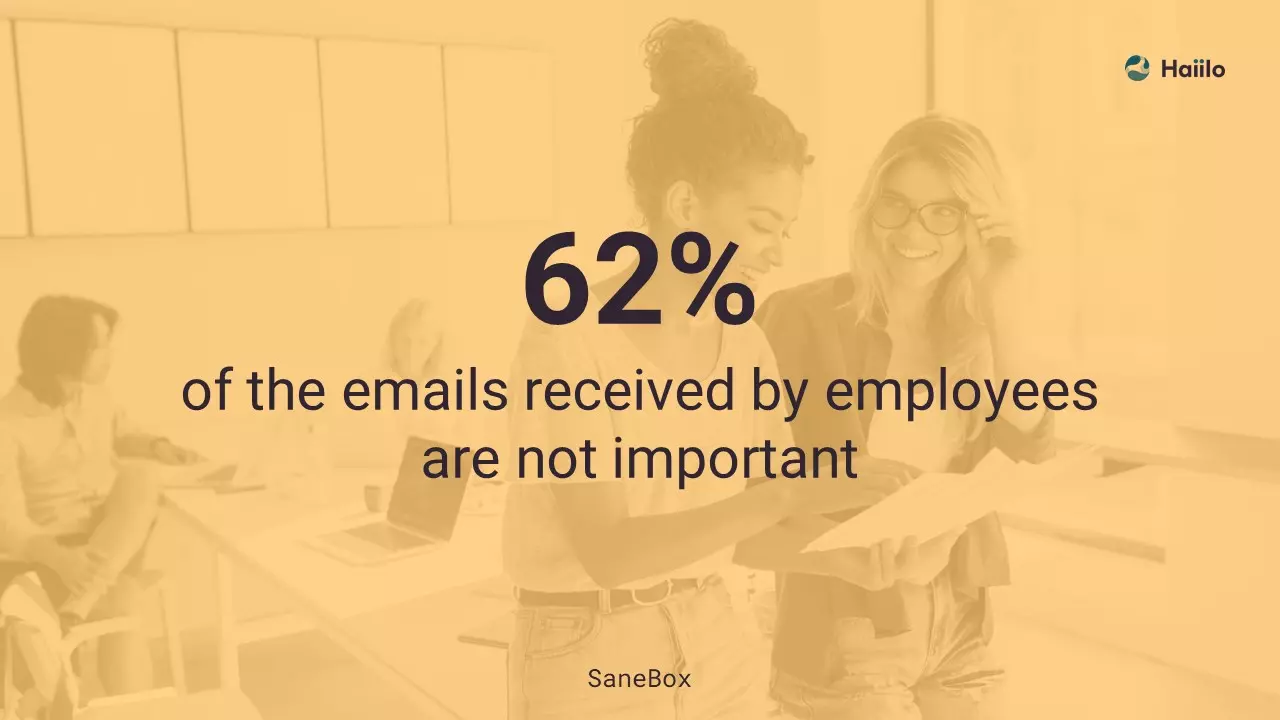
What’s more, it takes more than one minute to recover from an email. You clearly don’t want your employees to be interrupted with irrelevant emails.
Some companies are still using emails for their internal communications.
Because of email overload, important information you’d like to share to your employees may actually go unread!
If you don’t want your newsletters to get lost among lots of emails, you may want to reconsider your internal communications strategy and start using an employee communications app where you can engage your employees with your content!
9. Employees are 75% more likely to watch a video than read text
Yes, we all prefer to watch videos than read texts!
Most people are visual learners, including your employees!
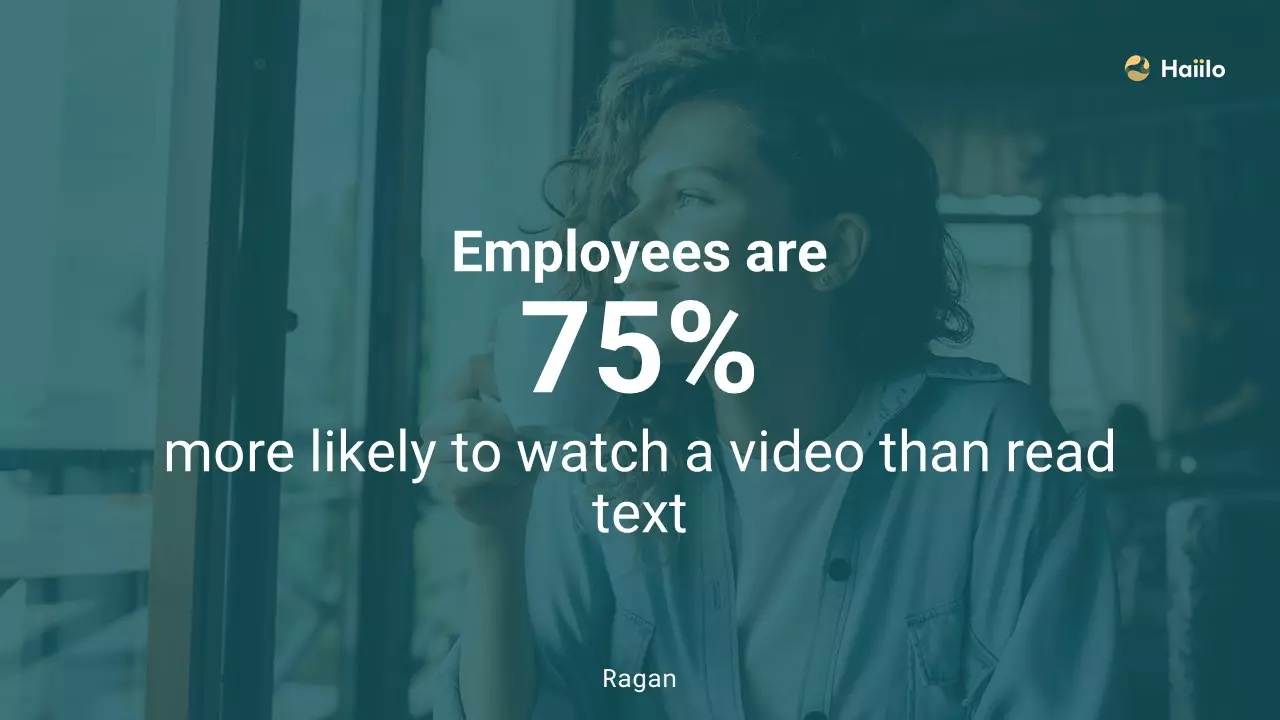
However, most CEOs and internal communicators are still sending out long emails or reports to their employees.
And do you know what happens in most cases?
Employees open the email or document, read the beginning of it, and quickly end up closing it.
When it comes to internal communications, the key is to share engaging content, content that employees actually want to read.
If you want to drive adoption, you may want to share videos, of course, but also infographics, interactive newsletters, pictures or podcasts!
10. Organizations with effective change and communication programs are 3.5 times more likely to outperform their peers
The way you communicate and engage with your employees has a direct impact on your business’s success.
One of the main communications challenges that most organizations are facing today is the silo effect where departments, teams or even employees from the same team don’t communicate enough.
As a result, they don’t coordinate their work in an effective way, and they may not even be aware of what the others are doing.

When teams don’t communicate enough, they may waste precious time because of duplication of work, or miss deadlines because interconnected projects were not actually coordinated.
Many reasons may cause a silo effect: geographical distances, remote work, complex internal structure, lack of communications tools…
This is where things get complicated — very complicated.
Organizations that manage to break down silos and improve their internal communications overall are more likely to outperform their competitors.
But getting rid of silos all together in your organization is not enough.
If you want to stay ahead of the competition and grow your business, you’ll need to rethink your communications strategy overall.
To turn your internal communications into a competitive advantage, ask yourself questions such as:
- What goals do you want to achieve with your internal communications?
- Are you able to measure your internal communications strategy right now?
- How do you plan to measure the effectiveness of your internal communications in the future?
- How silos are impacting your business right now?
- Can you measure those impacts on your business?
- Who’s going to oversee your employee communications: HR or internal communications ?
- What information do you want to share internally?
- To whom?
- What channels do you want to use?
- Are you using the right technologies to drive adoption?
- Do you want to help your employees be more active in internal communications?
- Do you want your internal communications to be customized based on your employees’ roles within the organization?
- How to help your managers to better communicate with their teams?
- Do you want your employees to become content creators?
- Should your internal communications be top-down or horizontal?
- Have you considered encouraging upward communication?
- How to drive dialogues within the organization?
- Do you want to collect feedback from your employees. If yes, how do you plan to do so?
📚Read also: Change Management: Definition, Best Practices & Examples
🎁 Bonus: Stats on Internal Communications in COVID-19 Times
Experts and analysts have started to release new research on the impacts of the COVID-19 pandemic on the workplace and our work habits.
Results show that building effective internal communications strategies is more important than ever and here’s why:
- The percentage of U.S. remote workers jumped from 31% to 62% in just three weeks (Gallup)
- 54% of HR leaders indicated that poor technology and/or infrastructure for remote working is the biggest barrier to effective remote working in their organization (Gartner)
- 35% of people surveyed by WhistleOut said that weak Internet has prevented them from doing their work at some point during the Coronavirus crisis and 43% said they have had to use their phone as a hotspot during the crisis (Forbes)
- A survey run in the UK during the pandemic showed that 73% of the respondents believed they were more efficient when working from home, 68% believed they worked more hours at home during the outbreak, and 25% said that working from home may have intruded on their personal life (Statistica)
- 22% of firms claimed that the COVID-19 disruption had no impact, or a positive impact on employee productivity while 15% said that it had a negative effect on productivity (Workplace Insight)
- 52% of managers say they will allow their employees to work remotely more often as a result of the two-month work from home experience (Gallup)
- Only 42% of employees strongly agree that leadership is effectively leading their organization through the crisis (Perceptyx)
- 85% of employees say they’re most motivated when management offers regular updates on company news (Trade Press Services)
- When employees are extremely satisfied with communications about the company’s response to coronavirus, 96% of them believe that their employer really puts their safety first. When communication is poor, only 30% of them believe so (Perceptyx)
- A recent survey of 2,000 participants in flexible work arrangements in China indicated that 63% were supportive of remote work, with 55% believing that their employer provided them with the software, tools and resources to work effectively (World Economic Forum)
- 74% of companies plan to permanently shift to more remote work post COVID-19 (Gartner)
Bottom Line
COVID-19 has disrupted the way employees communicate and collaborate. The shift to remote work has led IC practitioners to rethink the way they connect and engage with the employees and analysts agree that remote work is here to stay. Indeed, more than half of managers (52%) surveyed by Gallup said they will allow employees to work remotely more often post COVID-19.
It goes without saying that even though IC experts have changed their employee communications strategies during the pandemic, they’ll have to keep evaluating and adjusting their internal communication strategies once the coronavirus crisis will be behind us. Some employees are already back to the office while others are still working from home, and teams will most likely remain geographically dispersed post COVID-19 as most businesses are planning to keep offering flexible work arrangement in the future.
One of the best ways to ensure that your teams feel connected and stay motivated in these fast-changing times is to provide them with the right communication tools. Remember, your employees are your best asset, so make sure you provide them with the resources they need so they can give the best of themselves!
What’s next? Schedule a demo with us to get more tips & best practices for successfully communicating with your employees in today’s digital age.










